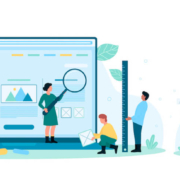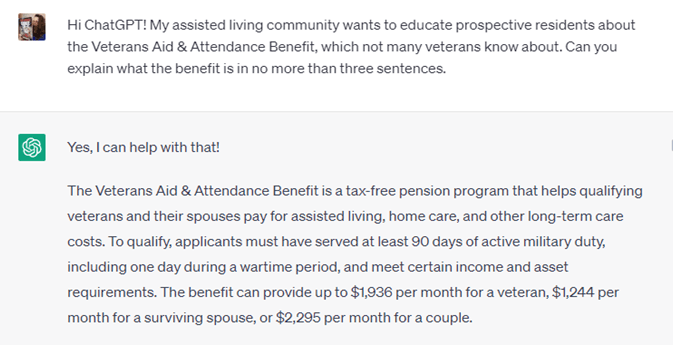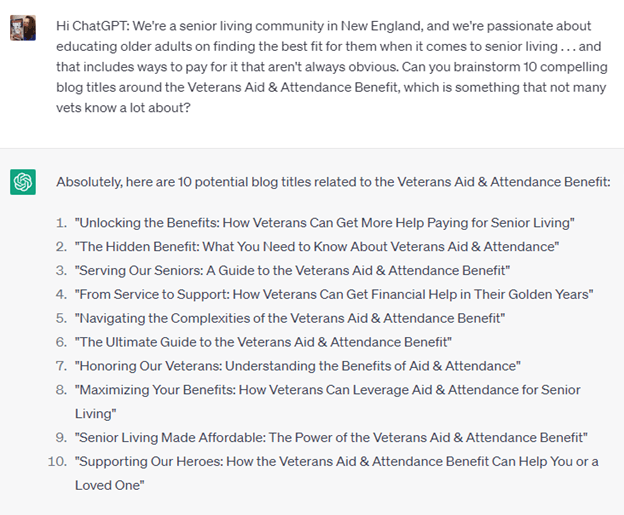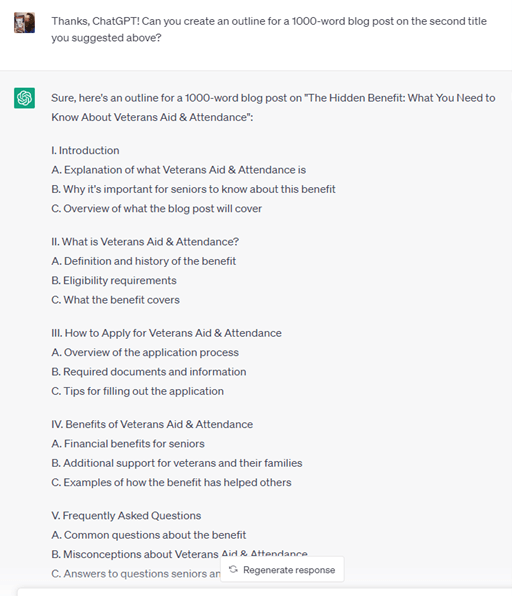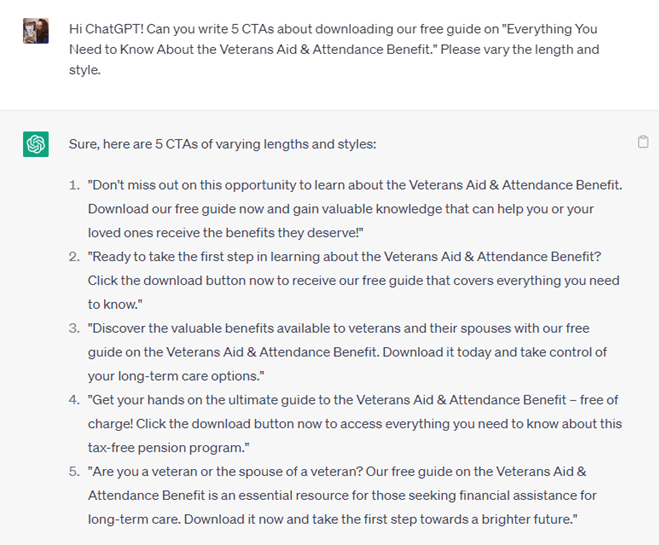We asked Chris Zook, Director of Paid Media & Strategy at Senior Living SMART, to sit down for a Q&A on all things Google Ads. Chris also did a podcast on this topic with our CEO, Debbie Howard. If you’d rather listen than read, here’s their conversation about Google Ads.
Otherwise, keep on scrolling for the text. Or click on the links below to jump to a specific section:
What are Google Ads, and how do they work?
Google Ads are pay-per-click (PPC) ads. With PPC ads, advertisers only pay for an ad if someone clicks on it.
Here’s some context on how this works: Google runs an auction that allows advertisers, like senior living communities, to bid on specific keyword phrases. For example, phrases like “assisted living,” “memory care,” or “dementia care.”
When someone searches on one of those phrases in Google, the auction determines who the top bidders are. Google will then list the PPC ads of the winning advertiser bidders on the search engine results page (SERP), starting with the highest bidder.
Again, advertisers don’t get charged unless someone clicks on their ad, so there’s value in having your PPC ad display even if no one clicks it. Someone might still glance at it and see your community’s name, which can help with name recognition down the line.
Google isn’t the only PPC option in town, either. Social media platforms like Facebook and Instagram offer PPC options, as do competing search engines like Bing.
It’s also worth noting that we’re discussing this in July 2023. Google recently announced its Search Generative Experience (SGE), which reimagines search and search results. Google makes money from advertisers, so it remains committed to showing ads. However, stay tuned since this is a fluid situation.
Here’s why PPC advertising is so effective for myriad businesses, large and small: You can bid on all kinds of keywords with whatever budget you have, and there’s almost always going to be an opening for you.
It’s not simply the tyranny of the big guy, although that can happen for certain industries. Even with modest budgets, we still see plenty of PPC opportunities for senior living communities.
Keep in mind that if a community finds that they’re not getting any clicks, at least they’re not dumping a ton of money into ads, because again, Google only charges you if people click on your ads.
How does Senior Living SMART optimize Google Ads to get clicks?
We follow PPC best practices and combine them with our knowledge of senior living in general and our understanding of a community’s brand, including the types of prospects they want to attract. (Learn more about prospect personas.)
We maintain a list of keywords that people search throughout the United States when researching independent living, assisted living, and memory care. We have an excellent grasp of these phrases because they’re fairly universal. It’s how everyone everywhere talks about senior living. Think of phrases such as “senior living near me” or “assisted living near me.”
From there, we get to know the client’s community, particularly the location and region. Every time we research a different region, we discover nuances and quirks of how people research assisted living, independent living, and memory care that we hadn’t seen before. This enables us to further refine the keyword list.
For example, we don’t use only “memory care” in our targeting because not everyone looking for memory care will necessarily call it that. We’ll use words like Alzheimer’s, dementia, and memory support. We’ll also pay attention to how people search in different markets.
We can target ads based on criteria like the person’s location, too. For example, let’s say we have a client who has a senior living community outside of Austin, Texas. We can target people within a 10- to 15-mile radius of Austin who are doing searches on things like “senior living near me,” or “assisted living near me,” or “senior living Austin.”
Why can’t you use financial criteria in the targeting?
It’s true that you can’t use financial criteria in your ad targeting. This is because of federal and state fair housing laws, which state that we cannot target housing based on people’s income. At the end of the day, senior living is a form of housing. For example, we can’t run ads where the criteria include targeting people interested in senior living in Austin who also have a yearly income of $300K.
But what we can do is help people self-qualify. Within the ads, we can include something like “Rents starting at $5,000/month”. Someone reading the ad can decide, “Yep, that works.” Or “Nope, I can’t afford that.”
Another tool we can use is “negative” keywords. Essentially, you’re telling Google that it shouldn’t show ads to people who use specific keywords. For example, consider people who search for “at-home assisted living.” We’d indicate “at home” (and various combinations and synonyms) as negative keywords, and Google wouldn’t show our ads to people who use those search terms.
What’s the definition of a PPC conversion rate, and is there a good benchmark for senior living?
A conversion rate for PPC ads is the percentage of people who convert after clicking your ad.
The definition of “convert” will vary depending on the advertiser. An e-commerce store running ads for perfume will consider a sale to be a conversion, but in senior living, there’s a much longer sales cycle. We don’t expect someone to click on an ad and convert into a resident. Instead, our goal is to convert the person into a lead.
For example, if someone clicks on an ad, they might go to a landing page where they can download a brochure in exchange for their name and email address. When a person takes that action, they become a senior living lead. That’s the conversion point.
If 100 people click your ad, and 10 become a lead, that’s a 10% conversion rate. We consider this a good conversion rate in our industry.
Conversion rates can vary depending on geographies and a community’s budget. Generally, we like to see conversion rates between eight to 15% for senior living.
Of course, clients will often say, “The conversion rate is only 10%? That means I lose 90% of the prospects clicking on the ad.”
On the surface, that might be true, but effective advertising is as much about allowing people to self-qualify out of your sales funnel as it is about bringing them into it. As much as you want to bring lots of people into your sales funnel, you also don’t want to waste anyone’s time on leads who will never become residents in your community, no matter what you do. And, that other 90% isn’t lost forever. Those folks can always come back and convert at a later date.
What are landing pages, and why are they super important in PPC campaigns?
You could be targeting the best keywords and have great ads that people click, but what if there’s a disconnect on the landing page—the place on your website that the Google Ad click sends them to? What if the landing page doesn’t deliver on what the ad promised, or it’s confusing, or it doesn’t function properly, and someone navigates away before converting? Well, you’ve just wasted money on that click.
To improve landing pages, we’ll conduct A/B testing. Sometimes, the smallest change—like changing the color of a submit button, for example—can improve conversions. We’re constantly monitoring landing page performance to achieve that desired conversion rate of 8 to 15%.
We’d be remiss if we didn’t point out that what happens to the leads after they convert matters, too. This is where lead scoring and marketing automation come into play. High-intent leads can go onto the sales team, while leads that aren’t ready for a sales interaction can continue to be nurtured through automated lead nurturing.
What are the cost per lead benchmarks for senior living PPC?
The lowest cost per lead right now is for independent living. They can be as low as $18 per lead, or as high as $45 to $50.
Assisted living is higher. Typically, we see the low end around $38 to $40. The high end is in the range of $80 to $100. Again, this depends on location. A densely populated metro area will likely be more competitive and more expensive.
Memory care is a moving target and is constantly getting more expensive since there’s so much competition. This isn’t surprising, either. Every community that offers memory care already knows it’s an urgent need and a lucrative source of move-ins. The lower end of memory care is about $100 to $120. The higher end can be $400 or more.
How does Senior Living SMART work with a client to develop their PPC budget?
We start by having a very open conversation with each client about goals for leads this year and how that breaks down per quarter and month. For example, the client might want ten leads a month, eight of which come from paid ads.
From there, we’ll do keyword research using the seed list of keywords as our base and review the geography. Google wants you to spend money, so it’s incredibly transparent about how much keywords cost in different geographies.
Using our ideal conversation rate as a guide—so again, for senior living, we’re happy if we can land in between 8 to 15%—we can do some reverse-engineering with the numbers.
For example, if we get a hundred clicks on assisted living keywords that cost X amount, and the goal is to convert 10 of them, what does that mean in terms of the cost per click? How do we spread that cost over 30, 31, or 32 days? PPC platforms operate on a monthly basis, but they parse your budget on a daily basis. And because of that, we use either 31 days—or if it’s a month with 31 days, we use 32 days to make sure we don’t go over budget—to figure out our daily budget.
Once we’ve reviewed these scenarios, we can recommend a budget to the client. If the budget isn’t what they had in mind, we can adjust while resetting expectations about leads. Instead of expecting eight leads a month coming in from PPC ads, they might need to adjust their expectations to five leads a month due to their budget constraints.
Can clients do PPC work on their own?
The question isn’t “can they.” In theory, anyone can run paid ads if they have money. The question is, should they? Effective paid advertising requires more than simply tinkering with the ad platform and entering a credit card. The paid ads team at Senior Living SMART are specialists with years of skill and expertise—and a track record of getting the results our clients seek.
We monitor campaigns and make tweaks so that we can optimize a client’s budget and get them the quality leads they’re looking for. It’s a dynamic process—setting and forgetting ads won’t yield quality long-term results. So having a partner like SLS to set up and manage your ads is one of the best investments you can make.
Need help getting better senior living leads through PPC campaigns? We can help.
Let’s discuss how we can turbo-charge your paid advertising strategy.





